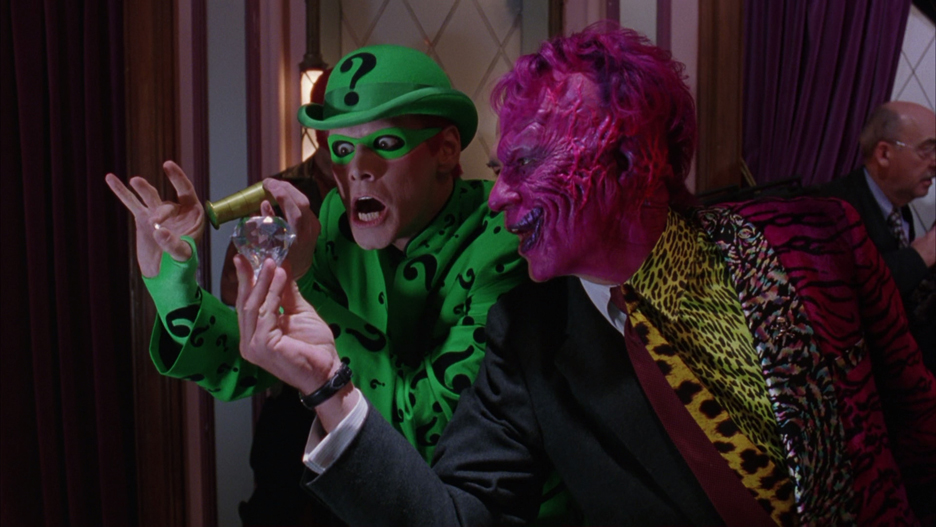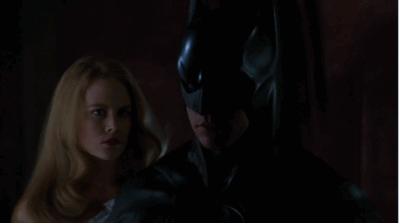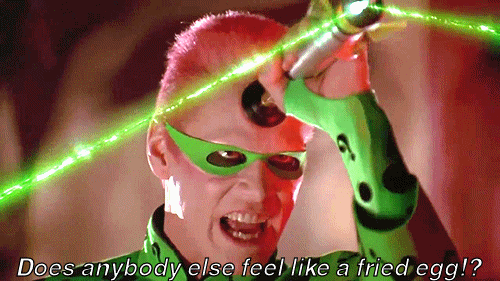Is Batman gay? According to my seventh grade schoolmates, Batman is “Sooooo Gay,” and so was I. It’s certainly a popular opinion among those with a basic understanding of psychology, one shared by noted anti-comic book doctor and Hater Hall-of-Famer Dr. Frederic Wertham. In Seduction of the Innocent, Wertham shamelessly misrepresented and misinterpreted years of superhero adventures to advance his own anti-comic book agenda. His argument about a Gay Batman inspiring homosexual crime is about as effective as one for Superman inspiring a wave of half-assed glasses-only disguises, and has already been dissected to crap by Andrew Wheeler at Comics Alliance in “The Gayness of Batman,” a comprehensive “Yeah, but fuck you if that’s a problem,” to bigots, chowderheads, and folks with no sense of humor about their hero in the skintight bat costume. Wheeler refutes the idea that Batman isn’t gay, and any “moral qualms” that homophobes might have with a gay Batman, but Wheeler glossed over the most nuanced gay Batman story ever to hit the screen. It’s a work that’s subtle in execution while achieving depth that evokes some of the most respected works of coded homosexuality on screen.
I’m talking, of course, about Batman Forever (1995, dir. Joel Schumacher).
Listen, I’m not saying that Batman Forever is a good movie. The dialogue’s insane, the performances are either wooden or obscenely annoying, and the plot holes are extensively documented. It’s only the hottest Val Kilmer performance in the Shirt-On, Occasional-Glasses division. All I’m saying is that there are layers here. Onions, Ogres, Batman Forever. Schumacher is homosexual, and caught flak from insecure bigots and dorks for making a gay Batman movie when Forever was released, and again in 1997 with Batman and Robin. While Batman and Robin star George Clooney has outright said he played Batman as gay, Schumacher has kept mum on the topic. I think he absolutely made a gay Batman movie, and I don’t just think that because every building in his vision of Gotham City is supported by a statue of a naked man.
If you weren’t a six-year-old boy in 1995, you might need to be reminded that the plot of Batman Forever concerns Millionaire Chiropteran Aficionado Bruce Wayne (Val Kilmer), whose nocturnal vigilante activities intersect with his civilian life when he adopts 25 year old teenage gymnast orphan Dick Grayson (Chris O’Donnell). Grayson’s parents are murdered, in an incident eerily close to the one that took Bruce’s own parents, by escaped supervillain Two-Face (Tommy Lee Jones). Two-Face takes in a stray of his own in his war on Batman, a former Waynetech employee named Edward Nygma (Jim Carrey), who adopts the nom-de-guerre of The Riddler after applying a question mark unitard to his naturally rubber band-like body. Nygma promises to reveal Batman’s identity to Two-Face in exchange for help getting revenge on Bruce Wayne. There’s ostensibly some sort of love story with psychologist Chase Meridian (Nicole Kidman), but as you can probably tell from the thesis above, neither the movie nor this article really give a shit about that, and that about covers the plot of Batman Forever.
It’s important to note that Edward Nygma’s obsession for most of the movie isn’t focused on Batman, but rather on Bruce Wayne. It’s Bruce Wayne’s face, plastered all over his cubicle, that inspires him to his work on his telepathic image projector, and it’s Bruce Wayne’s personal rejection that breaks Edward when he realizes that he and his idol are not in fact “Two of a Kind” (his words) together. “You were supposed to understand…” he whispers to himself. Later, at home, he witnesses Two-Face totally ruin whatever the Gotham Version of Cirque Du Soleil is, and, suddenly, his face lights up.
Nygma’s enthralled by the flamboyance, audacity, and anti-authoritarian flare that he hadn’t seen anywhere before but in himself. Compare the scene above to this one from Todd Haynes’ Velvet Goldmine, in which Christian Bale’s character, a teenaged gay male in working class Britain, watches the film’s Fake Bowie come out as gay on television:
It’s true that Velvet Goldmine was released years after Batman Forever, but there’s a similarity between Bale and Carrey’s expression of discovery and identification with the outrageous figures on television. They’re seeing people displaying traits that they had previously internalized and denied, and making that connection cast Forever in a new light for me. After viewing Two-Face’s bifurcated personality, Nygma sets to work dividing his own personality into two radically different pieces: there’s brilliant inventor Edward Nygma, and his dark counterpart, The Riddler. The Riddler proposes a simple partnership to Two-Face (his second in the movie, a duality I’m sure the former district attorney would appreciate) whereby Nygma would exchange Batman’s identity for Two-Face’s extralegal assistance in acquiring the seed money for Nygma’s plot to ruin Bruce Wayne. Check out that interaction, beginning one minute in, and keep your fingers away from the screen lest they get chewed off with the scenery.
http://youtu.be/7YywL43-xu8?t=1m
It’s a facile and borderline juvenile reading of that scene to view Carrey’s performance and body language with Jones as homoerotic, except that their plan to help each other destroy their enemies mimics the criss-cross of one of the most famous examples of coded homosexuality in cinema: Alfred Hitchcock’s Strangers on a Train (1950).
Strangers is an adaptation of Patricia Highsmith’s novel of the same name, a thriller about All-American tennis star Guy (portrayed by homosexual actor Farley Granger), whose chance encounter with a foppish psychopath named Bruno accidentally contracts him in a criss-cross murder plot that would solve problems in the lives of both parties, while keeping them free from suspicion with airtight alibis. Hitchcock’s film shares a surprising amount with Forever, including an amplification of homoerotic subtext present in their respective source material. Consider the way that Bruno’s appearance at a party that Guy is also attending (demonstrating a murder in the process) threatens the fabric of their plot, as Bruno’s own impatience and attempt at forcing Guy’s hand detracts from their plausible deniability:
In Forever, Nygma’s private supervillain identity and public persona nearly collide when Two-Face shows up at the Nygmatech gala in an attempt to draw out Batman. While there’s no footage of Two-Face’s entrance, enjoy this clip of Batman’s crusade against skylights from the same party, with the best ADR of all time:
Hell, there’s even a scene in which Two-Face does some violence coaching, like Bruno from the previous clip.
Though the structure of the crimes don’t exactly match (since The Riddler and Two-Face are actually attempting to kill the same man without realizing it), the two works are thematically bound at several points that suggest Forever has a deeper execution of subtext than the…entire rest of the movie…would suggest.
Let’s address the molded rubber elephant in the room: the production design of Every Single Thing Batman Owns. This is a movie in which the Batmobile, a phallic symbol in general, has an actual glans, and a biomechanical design inspired by the uncomfortable eros of H.R. Giger. Though Batman’s costume isn’t exactly skintight, he puts on a muscle suit with exaggerated nipples, bulge, and ass cheeks that make him look like he’s a Tom of Finland drawing. Dick Grayson, on the other hand, basically already looks like one. If I’ve accidentally made it sound like this is a movie about Evil Gays getting revenge then I’m sorry, I really view Batman Forever as a movie about two gay couples who fight each other in a city that looks like a giant molly-fueled nightmare. Meanwhile an accomplished beard is applied as set dressing, with the unfortunate task of trying to have sex with a completely uninterested Batman until it’s time to get put in a damn tube and make Bruce choose between saving her or Dick. Literally.
Any nuance is lost in the noise, but Schumacher is doing what Hitchcock did before him and amplifying the latent homoerotic tones of the source material, albeit with the careful hand of a man who put a half naked Rob Lowe poster in the closet of a fashion-obsessed teenaged boy in The Lost Boys—get it?
It’s not the first time Batman’s been camped-up, the same way that Strangers wasn’t the last time that the work of bisexual author Patricia Highsmith had coded homosexuality and gay themes amplified in a film adaptation. In 1999, director Anthony Minghella directed a film version of Highsmith’s The Talented Mr. Ripley, a tale about a con artist (Matt Damon) who impersonates a wealthy playboy (Jude Law), and the intrigue that ensues. Highsmith’s book version of the titular Mr. Tom Ripley was a pure sociopath who found no interest in sex outside its use as a cover for his criminal activity. However, in Minghella’s hands, the story between Damon and Law reads as a young man unable to process romantic feelings for another man who sublimates his urges through imitation. With that in mind, check out this clip of Edward Nygma at the launch party for Nygmatech, where he intends to replace Bruce in the public eye.
Saying that Joel Schumacher secretly snuck a psychologically complex gay love story into an otherwise ill-constructed big-budget comic book movie is a take so hot that it could melt structural steel, but art can be weird like that. In a genre in which LGBT characters are dramatically underrepresented, it’s common for fans to find queer implications about characters that are canonically straight in order to relate to them better. It’s not completely out of the question that, given the chance to actually control the direction of the characters, an LGBT person would find a way to make their head-canon a little more real. It seems that Schumacher took some advice that has always helped Batman himself, and used theatricality to distract his critics and create a legend larger than himself.





Reflections On Blue Mountain State – Return Of Kings …